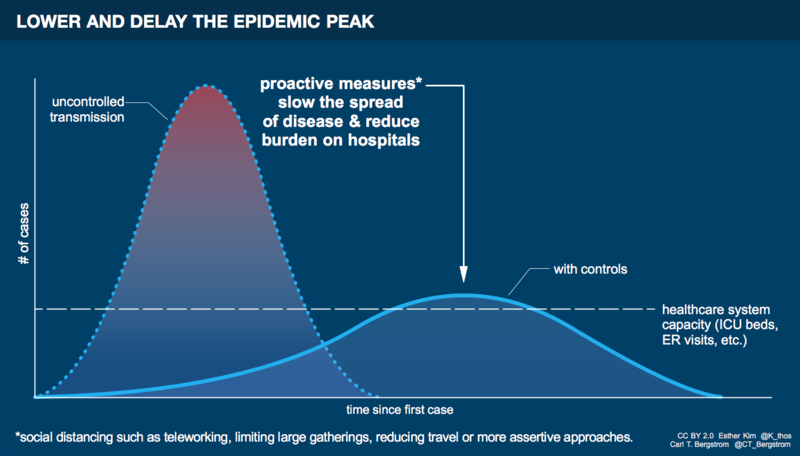The Science Behind “Flatten the Curve”
BERGSTROM VIA WIKIMEDIA COMMONS
The curve plots the number of new cases against the course of the coronavirus outbreak and demonstrates the potential outcome with or without the implementation of protective measures versus without.
April 1, 2020
The phrase “flatten the curve” has been thrown around on social media in light of the coronavirus pandemic, especially with regard to social distancing. The curve being referenced is the number of new cases plotted against the course of the coronavirus outbreak. This graph demonstrates two scenarios: what would happen with protective measures and what would happen without protective measures.
With protective measures like social distancing, the number of cases rises gradually and peaks much later. Without protective measures, the number of cases would rapidly increase as the virus spreads through a community, and then the curve would fall sharply since most of the people who could catch the virus have already been infected.
Though the outbreak lasts longer in the first case, the number of cases doesn’t overwhelm the health care system all at once. The curve with the sharp increase in infections results in the number of sick patients far exceeding the maximum amount of individuals the health care system can care for, and with hospitals operating past capacity to treat coronavirus patients, those needing care for other health emergencies won’t be able to get the care they need. Moreover, the lower rate of new infections buys time to develop vaccines or antiviral treatments.
The aim of flattening the curve is to make our reality in this pandemic reflect the shorter curve through the guidelines of public health agencies like the Centers for Disease Control and Prevention (CDC) and the Department of Health.
University Health Services Director Maureen Keown said, “By staying home and following the guidance from the Department of Health and the Centers for Disease Control, we can hopefully decrease the number of people getting infected. This will give the health care system some time to treat those who are ill today and be ready for those who may get ill in the future.”
Space in hospitals to treat new patients isn’t the only limiting factor in our health system. Hospitals have a limited amount of personal protective equipment, which includes masks, gloves and face shields; these supplies keep health care workers healthy while treating ill and highly contagious patients.
“This is a big problem because if they cannot protect themselves, they may become ill and we will have less health care personnel who will be available to care for the sick,” Keown said.
Another piece of equipment that’s rapidly becoming scarce in this crisis is ventilators. For critically ill patients, the go-to method of treatment is supportive care through the use of ventilators that increase the oxygen flow to the lungs. The shortage of ventilators in New York has gotten so severe that health care workers are using one ventilator to treat two patients at New York Presbyterian Hospital.
This strain on the health care system can be avoided through protective measures like social distancing. According to the CDC, “The best way to prevent the illness is to avoid being exposed to the virus,” since there is currently no vaccine. Social distancing involves staying indoors as much as possible in order to reduce face-to-face contact with people who could be sick with coronavirus.
States like New York and California have imposed shelter-in-place orders in order to curb the spread of coronavirus. Of course, individuals are allowed to leave their homes for necessity, but people should keep a distance of six feet from others.
Many students in the Fordham community are not at risk of dying from coronavirus. According to Keown, most people, if they get infected, will develop a mild case of the disease and will be able to recover without having to go to the hospital. Both the CDC and Keown emphasize that it’s imperative for these people who catch coronavirus to stay at home.
The people most at risk for developing a severe case of coronavirus are older adults and those of all ages with underlying medical conditions. These broadly include asthma, diabetes and conditions that cause immunosuppression. Though most Fordham students are young adults with fully functioning immune systems, we can still spread the virus to others that don’t have these advantages.











